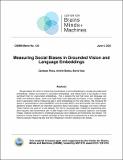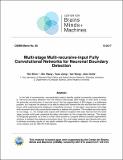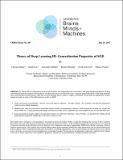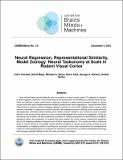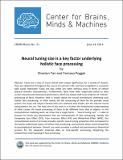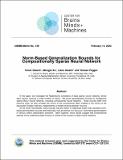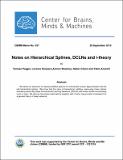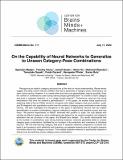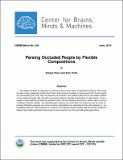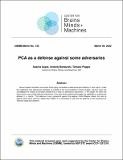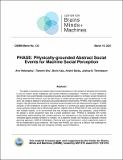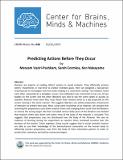Browsing Publications by Title
Now showing items 80-99 of 151
-
Measuring Social Biases in Grounded Vision and Language Embeddings
(Center for Brains, Minds and Machines (CBMM), Annual Conference of the North American Chapter of the Association for Computational Linguistics (HLT/NAACL), 2021-06-06)We generalize the notion of measuring social biases in word embeddings to visually grounded word embeddings. Biases are present in grounded embeddings, and indeed seem to be equally or more significant than for ungrounded ... -
Multi-stage Multi-recursive-input Fully Convolutional Networks for Neuronal Boundary Detection
(Center for Brains, Minds and Machines (CBMM), 2017-10-01)In the field of connectomics, neuroscientists seek to identify cortical connectivity comprehensively. Neuronal boundary detection from the Electron Microscopy (EM) images is often done to assist the automatic reconstruction ... -
Musings on Deep Learning: Properties of SGD
(Center for Brains, Minds and Machines (CBMM), 2017-04-04)[previously titled "Theory of Deep Learning III: Generalization Properties of SGD"] In Theory III we characterize with a mix of theory and experiments the generalization properties of Stochastic Gradient Descent in ... -
Neural Regression, Representational Similarity, Model Zoology Neural Taskonomy at Scale in Rodent Visual Cortex
(Center for Brains, Minds and Machines (CBMM), The Thirty-fifth Annual Conference on Neural Information Processing Systems (NeurIPS), 2021-12-06)How well do deep neural networks fare as models of mouse visual cortex? A majority of research to date suggests results far more mixed than those produced in the modeling of primate visual cortex. Here, we perform a ... -
Neural tuning size is a key factor underlying holistic face processing
(Center for Brains, Minds and Machines (CBMM), arXiv, 2014-06-14)Faces are a class of visual stimuli with unique significance, for a variety of reasons. They are ubiquitous throughout the course of a person’s life, and face recognition is crucial for daily social interaction. Faces are ... -
A Nonparametric Bayesian Approach to Uncovering Rat Hippocampal Population Codes During Spatial Navigation
(Center for Brains, Minds and Machines (CBMM), arXiv, 2014-12-01)Rodent hippocampal population codes represent important spatial information about the environment during navigation. Several computational methods have been developed to uncover the neural representation of spatial topology ... -
Norm-Based Generalization Bounds for Compositionally Sparse Neural Network
(Center for Brains, Minds and Machines (CBMM), 2023-02-14)In this paper, we investigate the Rademacher complexity of deep sparse neural networks, where each neuron receives a small number of inputs. We prove generalization bounds for multilayered sparse ReLU neural networks, ... -
A normalization model of visual search predicts single trial human fixations in an object search task.
(Center for Brains, Minds and Machines (CBMM), arXiv, 2014-04-25)When searching for an object in a scene, how does the brain decide where to look next? Theories of visual search suggest the existence of a global attentional map, computed by integrating bottom-up visual information with ... -
Notes on Hierarchical Splines, DCLNs and i-theory
(Center for Brains, Minds and Machines (CBMM), 2015-09-29)We define an extension of classical additive splines for multivariate function approximation that we call hierarchical splines. We show that the case of hierarchical, additive, piece-wise linear splines includes present-day ... -
Object-Oriented Deep Learning
(Center for Brains, Minds and Machines (CBMM), 2017-10-31)We investigate an unconventional direction of research that aims at converting neural networks, a class of distributed, connectionist, sub-symbolic models into a symbolic level with the ultimate goal of achieving AI ... -
On Invariance and Selectivity in Representation Learning
(Center for Brains, Minds and Machines (CBMM), arXiv, 2015-03-23)We discuss data representation which can be learned automatically from data, are invariant to transformations, and at the same time selective, in the sense that two points have the same representation only if they are one ... -
On the Capability of Neural Networks to Generalize to Unseen Category-Pose Combinations
(Center for Brains, Minds and Machines (CBMM), 2020-07-17)Recognizing an object’s category and pose lies at the heart of visual understanding. Recent works suggest that deep neural networks (DNNs) often fail to generalize to category-pose combinations not seen during training. ... -
On the Forgetting of College Academice: at "Ebbinghaus Speed"?
(Center for Brains, Minds and Machines (CBMM), 2017-06-20)How important are Undergraduate College Academics after graduation? How much do we actually remember after we leave the college classroom, and for how long? Taking a look at major University ranking methodologies one can ... -
On the Robustness of Convolutional Neural Networks to Internal Architecture and Weight Perturbations
(Center for Brains, Minds and Machines (CBMM), arXiv, 2017-04-03)Deep convolutional neural networks are generally regarded as robust function approximators. So far, this intuition is based on perturbations to external stimuli such as the images to be classified. Here we explore the ... -
Parsing Occluded People by Flexible Compositions
(Center for Brains, Minds and Machines (CBMM), arXiv, 2015-06-01)This paper presents an approach to parsing humans when there is significant occlusion. We model humans using a graphical model which has a tree structure building on recent work [32, 6] and exploit the connectivity prior ... -
Parsing Semantic Parts of Cars Using Graphical Models and Segment Appearance Consistency
(Center for Brains, Minds and Machines (CBMM), arXiv, 2014-06-13)This paper addresses the problem of semantic part parsing (segmentation) of cars, i.e.assigning every pixel within the car to one of the parts (e.g.body, window, lights, license plates and wheels). We formulate this as a ... -
PCA as a defense against some adversaries
(Center for Brains, Minds and Machines (CBMM), 2022-03-30)Neural network classifiers are known to be highly vulnerable to adversarial perturbations in their inputs. Under the hypothesis that adversarial examples lie outside of the sub-manifold of natural images, previous work has ... -
PHASE: PHysically-grounded Abstract Social Events for Machine Social Perception
(Center for Brains, Minds and Machines (CBMM), The Thirty-Fifth AAAI Conference on Artificial Intelligence (AAAI), 2021, 2021-03-19)The ability to perceive and reason about social interactions in the context of physical environments is core to human social intelligence and human-machine cooperation. However, no prior dataset or benchmark has ... -
Predicting Actions Before They Occur
(Center for Brains, Minds and Machines (CBMM), 2015-10-26)Humans are experts at reading others’ actions in social contexts. They efficiently process others’ movements in real-time to predict intended goals. Here we designed a two-person reaching task to investigate real-time body ... -
Probing the compositionality of intuitive functions
(Center for Brains, Minds and Machines (CBMM), 2016-05-26)How do people learn about complex functional structure? Taking inspiration from other areas of cognitive science, we propose that this is accomplished by harnessing compositionality: complex structure is decomposed into ...

